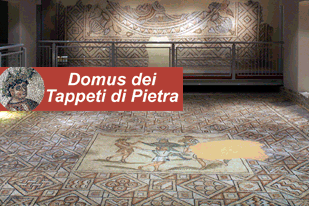The Walls, the Doors and a solitary Torrione.












The Walls, the Doors and a solitary Torrione. Hotels in the downtown of Ravenna.
Photo:1)the rests of the ancient Porta Aurea, 2)the Porta Serrata on via di Roma, 3/4)a Torrione on the Valentinano III wall, 5)the Porta Adriana on via Cavour, 6)the Porta Gaza on via S.Teresa, 7)the Porta Nuova on via di Roma, 8)the Porta S.Mama on via Baccarini, 9)the Porta Sisi on via Mazzini, 10)the Torre Zancana with the church of Madonna del Torrione and the mosaic scuplture
There are two versions of the origins of the walls of Ravenna: the first traditional theory is that a walled circle first emerged in the 1st century BC, of a squared shape and which enclosed a fairly restricted area. These walls were thought to have been extended by Valentiniano lll and Odoacre in the 5th century.
The second hypothesis is based on the near impossibility of the construction of the walls at the time of Claudius, they being walls that would have defended only a tenth of the town, excluding both the military port and its extensive docks, the ship yards, and the arsenals, Classe e Cesarea (A.Roncuzzi).
The excavations of the 1970’s by this same Roncuzzi, would appear to confirm that the walls dated back too the fifth century, as the height of the town in the first century was at least 2 metres less in altitude.
Having said, this for those who are not worried by archaeological matters and only seek a pleasant walk in the open air, it is possible to exit to the right from via Porta Aurea, for the short climb that takes you above the walls.
This path is shaded by holm-oaks, pines and cypress trees. On the right it is possible to see the vast prison complex; a box wood hedge and a long row of pines that separates us from the town. Going past the prison buildings, beneath the walls you can see houses to the left and right.
After about two-hundred metres we descent to via Cura, which we cross and then ascent from the opposite side until we reach the rear of a church where the town walls turns at a right angle towards the North-east.
A vast embattled tower was built at this corner of the walls in 1496, known as the Zancana tower, by Andrea Zancano, a Venetian Podestà.
A work of fortification of some beauty, as demonstrated by an elegant series of marble corbels of which the remains are still visible.
The tower took the place of a staging element which is in turn incorporated a tower that was in existence as far back as the 14th century. The Zancana Tower was demolished in 1730, right down to the wall level in order to build a church called “Madonna del Torrione”, which was intended to host an image of the Madonna del Sudore.
It is now time to return after a short stop under the third cypress tree, with a leisurely glance around, ending with a look at the fountain which can be seen on the other side of the road, a mosaic work of fine proportions and elegance, the work of Marco Bravura, who named it the “Ardea Purpurea”.
The return to Porta Aurea holds an interesting surprise: from the top of climb it is possible to admire two very low circular relics to the right and left of the road.
Which are the remains of the two towers which were alongside the legendary Porta Aurea. The building did not originate as a gate, but as a triumphal arch to welcome the emperor Claudius on his arrival in Ravenna, in the middle of the first century AC, the gate being decorated with a host of marble decorations.
The image is well known as it appears on an ancient town seal, and especially thanks to the Sangallo and Palladio reliefs, which they were able to draw a few years before its demolition in 1582.
But let us return to the town gates (there being in fact a total of six) that are still intact and we shall begin the tour from Porta Serrata, which is an imposing structure on the Northern end of Via di Roma. Built in 1582 (roughly around the time that of the demolition of Porta Aurea, from which certain marble sections were taken which we can actually see here), they were originally positioned at a lower altitude.
Prof. Gianni Morelli
The pleasure of fine accommodation in the centre of Ravenna: we recommend the Fabbri hotels for a pleasant stay as follows:
The Centrale Byron hotel, 3-star hotel in the centre of Ravenna, near the walls of Ravenna;
The Bisanzio, 4-star hotel in the centre of Ravenna, near the walls of Ravenna;
Once you have reached the hotel and parked your car, forget it and walk everywhere, because everything is within walking distance.
The railway station is near our hotels and within walking distance.
© reserved copyright





